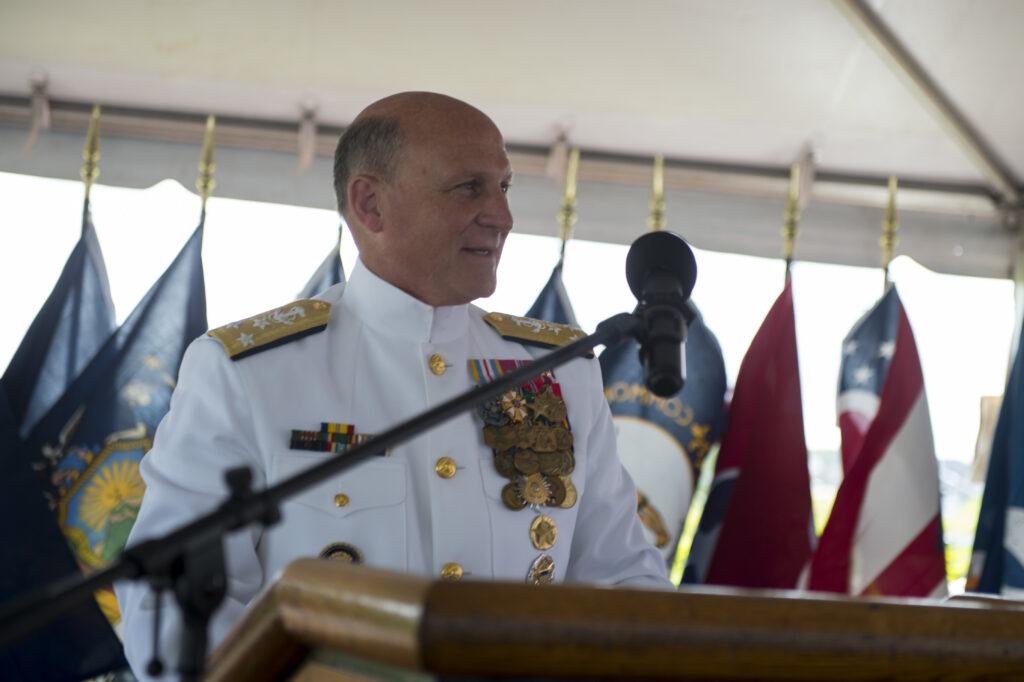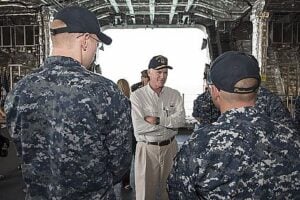Inhofe: Navy ‘Arrogance On USS Ford ‘Oughta Be Criminal’
Posted on

Vice Adm. Michael Gilday, commander, U.S. Fleet Cyber Command and U.S. 10th Fleet, is nominee to be CNO.
CAPITOL HILL: The head of the Senate Armed Service Committee today charged Navy leadership with “a level of arrogance” in dealing with the failures of its new $13 billion USS Gerald R. Ford aircraft carrier, saying the lack of planning for key new technologies that have struggled to perform “oughta be criminal.”
Sen. Jim Inhofe’s comments came during the nomination hearing for the next Chief of Naval Operations, Vice Adm. Mike Gilday, who was on the spot to answer for years of maintenance delays, modernization stumbles, and the struggle to grow to a 355-ship fleet in a two-hour hearing.
The hearing — generally friendlier than that might make it seem at first glance — presented the image of a service struggling to modernize at a critical time as commitments mount in the Pacific, Arctic, and North Atlantic, as China churns out new warships at a rate unmatched anywhere else on the globe.
Inhofe assured Gilday he realized the admiral isn’t responsible for any of these issues, but kicked off the proceedings with pointed questions about the Ford, along with a litany of issues plaguing the Navy.
The Navy is both under-manned and its hulls under-maintained, with close to 70 percent of ships unable to get through maintenance availabilities on time, Inhofe said, noting there’s $1.8 billion in outstanding maintenance needs still unfunded. “Overall,” the senator added, “it seems to me that the Navy is having trouble maintaining today’s fleet of 291 ships, and the challenges will only grow as the fleet surpasses 300 ships in 2020 and 310 ships in 2022, on the way to 355 ships in the 2030s.”
The chief concern on the Ford is the fact that only two of 11 weapons elevators work, and there is no timeframe for getting the rest online. The elevators, which pull munitions from below deck topside for aircraft on the deck, are a new electromagnetic design that has bedeviled Navy planners. The service has called in a team of experts from commercial industry to help out.

The USS Gerald R. Ford
The Navy decided against testing the electromagnetic lifts on shore before placing them on the ship, thinking that since similar technologies are used in the commercial sector, it would be “low risk” to do so, Gilday said. Concerning those issues, Gilday said he “would consider that a failure of the Navy,” not shipbuilder Huntington-Ingalls.
Inhofe’s comments can be seen as a direct shot at current Chief of Naval Operations, Adm. John Richardson and Secretary Richard Spencer, both of whom have pledged to fix these issues with little success. Richardson will retire once his replacement is sworn in.
Inhofe added that Navy leadership’s underplaying of the scope and seriousness of the failures on the Ford “indicated either poor knowledge or poor judgement,” language somewhat uncommon for a man who is normally eager to confirm and praise military leadership.
Inhofe noted that “there are problems with the Ford beyond the elevators, and those problems have to do with the arresting gear, catapult and the radar.” He asked Gilday to provide the committee with regular updates on the carrier’s progress. He also noted that Spencer told President Trump the Commander-in-Chief could fire him if all of the elevators aren’t working by the time the ship heads out to sea on trials. Those trials are scheduled for later this year, and there is little hope the elevators will be fixed by then.

Navy Secretary Richard Spencer talks to sailors aboard the USS Giffords
Gilday confirmed to the committee that the Columbia-class nuclear submarine remains the Navy’s top priority, and that he is making sure the industrial base is prepared for continued builds of the boat that will be a key part of the United State’s nuclear triad in the coming decades. That will be no small task as the submarine industrial base will be asked in short order to double production rates from two submarines a year to at least four, which include the upgraded Virginia-class subs.
The admiral said work is pushing forward on the Columbia, and it’s on track to have 80 percent of the design work done by next year. In a nod to the Ford’s failures, he said that “any new technologies we introduce to those submarines are tested” well before being installed on the boat.
Gilday is expected to cruise through confirmation, as senators on both sides of the aisle said they look forward to confirming him, and none expressed public opposition. He was nominated earlier this month after the Trump administration’s original nominee, Adm. Bill Moran, removed himself from consideration after Navy Secretary Spencer called his judgment into question over his continued correspondence with retired Cmdr. Chris Servello, the service spokesman who left the Navy after allegedly groping a civilian staffer and making unwanted sexual advances toward junior officers.
Gilday’s nomination was somewhat of a surprise, as the former commander of 10th Fleet and the Navy’s cyber arm, was outranked by seven sitting four-star admirals. Such a move hasn’t happened since 1970 when then-Vice Adm. Elmo Zumwalt was nominated to be CNO, leapfrogging over a clutch of four-stars. It may be a sign that the Trump administration wants the Navy shaken up.
Subscribe to our newsletter
Promotions, new products and sales. Directly to your inbox.
